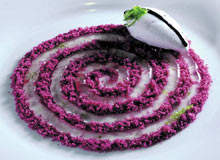
The phenomenon of restaurants becoming celebrities in their own right has
seen a marked shift in the way many hotels approach dining facilities and their
relationship with them. An exceptional restaurant will now create a buzz
capable of travelling well beyond its domestic market.
For example, Ferrán Adriá, head chef of El Bulli and The
New York Times’ Chef of the Century, is a name familiar to any
self-respecting foodie, despite the small number capable of making the culinary
pilgrimage to Catalonia to sample his fare.
The chief reason for his and the industry’s celebrity is simple:
Michelin. The Michelin Star system, now present in 21 countries and recognised
in countless more, is the last word in quality. “I like to think we have had a
part to play in this shift,” says Jean-Luc Naret, director of the
Michelin Guides. “For a gastronomic tour, people used to visit
France. Now, they are not so restricted. And, as we extend our territories, an
increasing number of people will come round to our opinion.”
GLOBAL PHENOMENON
Expansion has enabled the Michelin Guide’s focus to shift
beyond the merely geographical, its November 2005 expansion into New York being
a prime example. “If we had arrived there 20 years before, we would have been a
French company writing about French food,” says Naret. “At that time we did not
have the expertise and knowledge of global cuisine. What our London guide
proved was that now we did.”
See Also:
One need spend only a short time in Naret’s company to recognise his
pride in heading up the organisation. He speaks passionately about its 107-year
history, independence and reputation. “We are not in this to please the chef or
hotelier,” he says. “The stars are a major part, but they only represent 5% of
what we are about. We are here to offer our readers the best selections of
hotels and restaurants in all categories. Ours is the report of Mr and Mrs
Smith for Mr and Mrs Smith.”
How well do you really know your competitors?
Access the most comprehensive Company Profiles on the market, powered by GlobalData. Save hours of research. Gain competitive edge.

Thank you!
Your download email will arrive shortly
Not ready to buy yet? Download a free sample
We are confident about the unique quality of our Company Profiles. However, we want you to make the most beneficial decision for your business, so we offer a free sample that you can download by submitting the below form
By GlobalDataA graduate of École Hôtelière de Paris, Naret managed a
variety of hotels and resorts over a 20-year period and was head of operations
for a group of Aga Khan hotels prior to joining Michelin in 2003. In preparing
for the role, Naret spent six months with his inspectors in Europe and visited
the US, analysing the potential for Michelin expansion. “As the sole party
present at all meetings and discussions on strategy, I wanted to become
familiar with the entire process,” he says.
Exporting the Michelin Guide to the US – there is now a guide
for San Francisco as well as New York – has been one of the main concerns
during his stewardship, and the move’s success has demonstrated the
brand’s strength. “Eric Ripert at Le Bernardin has seen reservation
enquiries increase by 35% since publication,” Naret says proudly. “It is the
same for Jean Georges, and Ducasse doubled its number. It has also made a
difference to the restaurant landscape – Ramsay has been attracted by our
presence, as have others.”
CHANGE IN HOTEL DINING
Gordon Ramsay at the London, housed within Manhattan’s London Hotel,
became the latest component of the British super chef’s restaurant empire
in October 2006, and reflected the increasing trend towards hotels importing
internationally recognised brand names to run restaurant operations.
“Fifteen years ago, there were beautiful hotels with incredible dining
rooms, but no star,” Naret remembers. “The food wasn’t good enough and
didn’t attract the clientele. When guests arrived, their first step was
to contact the concierge and arrange an outside reservation. It’s very
positive that investors are realising that incredible chefs the world over can
fix this.
“A concept – for example, Nobu – will appoint its own people and
can be instantly trusted. In some cases, the winning of a star is written into
the contract. Gastronomy has become part of the deal.”
INSPECTION PROCESS
Alain Ducasse was the first chef to hold three stars in three different
cities, and the same names continually gaining recognition can expose Michelin
to accusations of favouritism. “Inspectors aren’t looking at the name,”
Naret retorts. “They don’t care whether the chef is on television or how
many of his cookbooks you might have on your shelf. They enter the restaurant
and look solely at what is on the plate: the quality of ingredients, how they
are cooked, how well the flavours are kept, presentation, personality and
consistency.”
The exact criteria for gaining Michelin recognition remain a closely guarded
secret and critics have accused the system of snobbery and a Gallic bias.
“Complete bunkum,” says Naret.
“There are 40 types of cuisine in the London guide,” he says. “We are giving
stars to Indian, Chinese and Japanese restaurants. Go to a starred
establishment in France and your table will be a tiny piece of real estate,
owned for the entire evening. In New York, your table is far more likely to be
turned, but that does not mean that the quality is not there. A star in London
should be equivalent to a star in Paris, but that doesn’t mean that the
experience should be the same.”
TALENT-SPOTTING
In terms of recognising culinary accomplishment, Naret explains the
books’ role succinctly. “Our job is not about setting the gastronomic
trends of tomorrow,” he explains. “We must reveal the talent of chefs working
today. Sure, we can be very conservative − Alain Ducasse is an example
− but we were also the first to recognise Adriá.
“In a small village outside London (Bray) you will find two three-starred
establishments. The Waterside Inn is not far off white-gloved service while the
Fat Duck is in a converted pub that provides an altogether different type of
dining experience. That’s what Michelin is all about: very good food in
very different environments.”
Finding the next Adriá or Blumenthal is a driving force behind the
30,000km spent on the road, the 150 nights in hotels, the 250 meals and the 800
open visits that are the average inspector’s annual lot. “Being the one
to first put a person on the map is of great pride to an inspector,” Naret
explains. “Many are betting on the future of certain chefs and there are
certainly some that we are following very closely.”
To stress the importance of carving out an identity, Naret recounts being
invited by the European Hotel Managers Association to comment on the future of
the hotel industry: “One of the things I stressed was that before the end of
this decade 80% of hotels will belong to only ten or so groups. This will
provide an opportunity for the remaining 20% to really demonstrate their
independence.
“Food is a big part of that. The beauty of gastronomy and the hotel business
is that you can choose what you want to do for your consumer. Just make sure
you get it right.”







